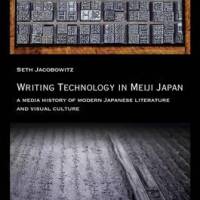The industrial and social revolution that Japan underwent in the Meiji Era (1868-1912) was accompanied by an equally tumultuous revolution in the Japanese language. It's perhaps hard to fathom today that throughout the latter half of the 19th century, an almost unbridgeable gulf existed between written and spoken Japanese.
Writing Technology in Meiji Japan, by Seth Jacobowitz
312 pages
Harvard University Press, Nonfiction.
So complex and daunting was the shock of linguistic innovation, and the task of national standardization, that a profusion of now largely forgotten suggestions were made by eminent intellectuals and bureaucrats as to how Japan should respond to the challenge. These varied from such extremes as the wholesale adoption of English to using completely new methods of shorthand annotation as the standard writing system.
Seth Jacobowitz places Japan's linguistic revolution in the wider, international context of ongoing technological advances from the telegraph to the telephone, and argues that English, too, was very far from being static, being in the throes of campaigns for simplified spelling or the proposed adoption of international languages such as Esperanto.
The ultimate destination of Jacobowitz's book is the publication in 1905-6 of Natsume Soseki's "I am a Cat," the landmark novel that stands alongside Sterne's "Tristram Shandy" and Joyce's "Ulysses" as a profound contemplation on the potentiality of literature itself. It's occasionally a bit of an odyssey through linguistic theories to get there, but Soseki's literary genius eventually rises Excalibur-like out of the quagmire of linguistic confusion.



















With your current subscription plan you can comment on stories. However, before writing your first comment, please create a display name in the Profile section of your subscriber account page.